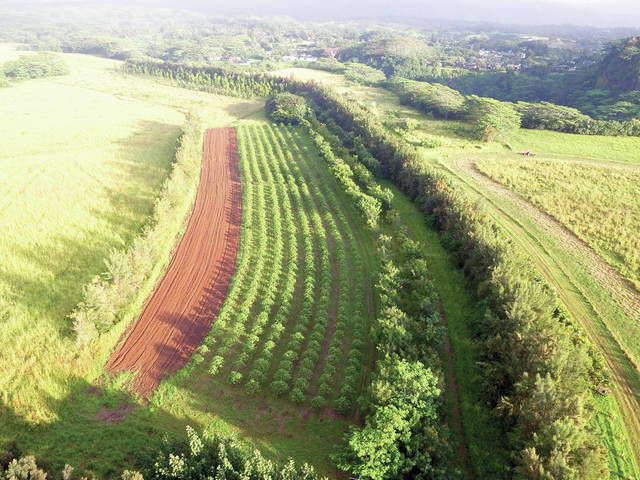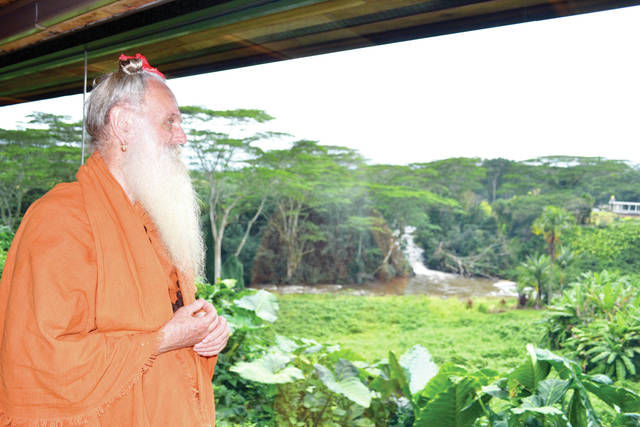he Garden Isle’s Hindu Monastery is part of a group of local farmers converting hundreds of acres of sugarcane parcel into ranching and farming land. In the last few years, under the Agribusiness Development Corporation, the land was transferred to
he Garden Isle’s Hindu Monastery is part of a group of local farmers converting hundreds of acres of sugarcane parcel into ranching and farming land.
In the last few years, under the Agribusiness Development Corporation, the land was transferred to Department of Land and Natural Resources to the Department of Agriculture, said Arumuganathaswami, a monk with Saiva Siddhanta Church.
The group of farmers were able to receive 35-year licenses on the parcels which run anywhere from 20 acres to 400 acres.
“We have love of this land, this aina. Besides taking care of our own original 70 acres, our guru thought he wanted to care for more,” said Paramacharya Sadasivanathaswami. “We saw what happened when the sugar companies abandoned this 6,000-plus acres along the way. We saw it immediately just deteriorate. We saw that the community had no way to preserve the water system that was in place because the sugar company maintained it all, and they were no longer there to do it. This is a $250 million irrigation system that was going to be abandoned.”
On March 11, monks from the monastery will join other experts in a forestry workshop that will show landowners how they can benefit from state and federal landowner assistance programs that support private forest restoration efforts, according to DLNR Division of Forestry and Wildlife officials.
The workshop’s focus is on forest management for early and mid-growth forests and the development of food forests. It was developed with input from the Kauai Garden Island RC&D Forestry Committee, and features visits to landowners who are implementing such projects. Only 20 tickets are available and interested landowners must register in advance.
The monastery’s goal is to grow koa and mahogany timber, agricultural products such as noni, and a seed plantation for Kauai low-elevation koa that is disease- and rust-resistant, to be utilized by the monastery and community.
“We have the attitude that every Kauaiian should help Kauai in some fashion or another. This is one way we can help,” Sadasivanathaswami said. “Our founder, Subramuniyaswami, also saw this as a way to endow the monastery in the future, so that this generation of monks could take care of planting, for example, 100 acres of hardwood trees that 50 years from now could be quite valuable and could help support the monks.”
The monastery has benefited from three grants from the National Resource Conservation Service funds to plant a total of 30 acres of native Hawaiian Koa, of which 50 percent has been planted.
Additionally, Saiva Siddhanta Church received a grant from the Forest Stewardship Program of the Hawaii Department of Forestry and Wildlife to plant about 35 acres of Honduras Mahogany, of which 10 acres of the area was planted. Currently, 4,000 seedlings is in the monastery’s nursery.
About 80 acres will be used for a hardwood tree plantation, which is being funded by an undisclosed amount of federal monies, the monks said.
“The advantage of hardwood trees is if the market fluctuates on you for the value of the longer, you can just wait,” Arumuganathaswami said. “When we started that, it was like, ‘Well, it’s only like teak wood has been valuable for the last 2,000 years. I’m sure it will be valuable today.’”
The monastery also used the land to grow specimen palm trees and noni plants that are processed, juiced and sold to 12 stores on Kauai and four in Oahu.
The land was previously in sugarcane production and once that industry left, it was fallow until the Saiva Siddhanta Church began working in the area in 2001.
When the sugar company walked away, Arumuganathaswami said the DLNR was going to shut down the water system used to cultivate the former sugar land.
“When we started the water system, we had to consult with 47 county, state and federal agencies. That was astounding,” he said. “You just wonder how on Earth people can do things like that and succeed. It is one of the few community-run water systems in the state.”
Arumuganathaswami said a few monks work on the noni and palm trees each week. Three hired workers cover daily maintenance and planting.
“Right now, one of the things we’re doing is providing testimony from the East Kauai Water Users Cooperative to the state Legislature for a bill that clears the way for the DOA to run these water systems without getting entangled in laws that are made for public utilities potable water systems,” he said.



